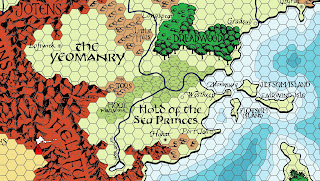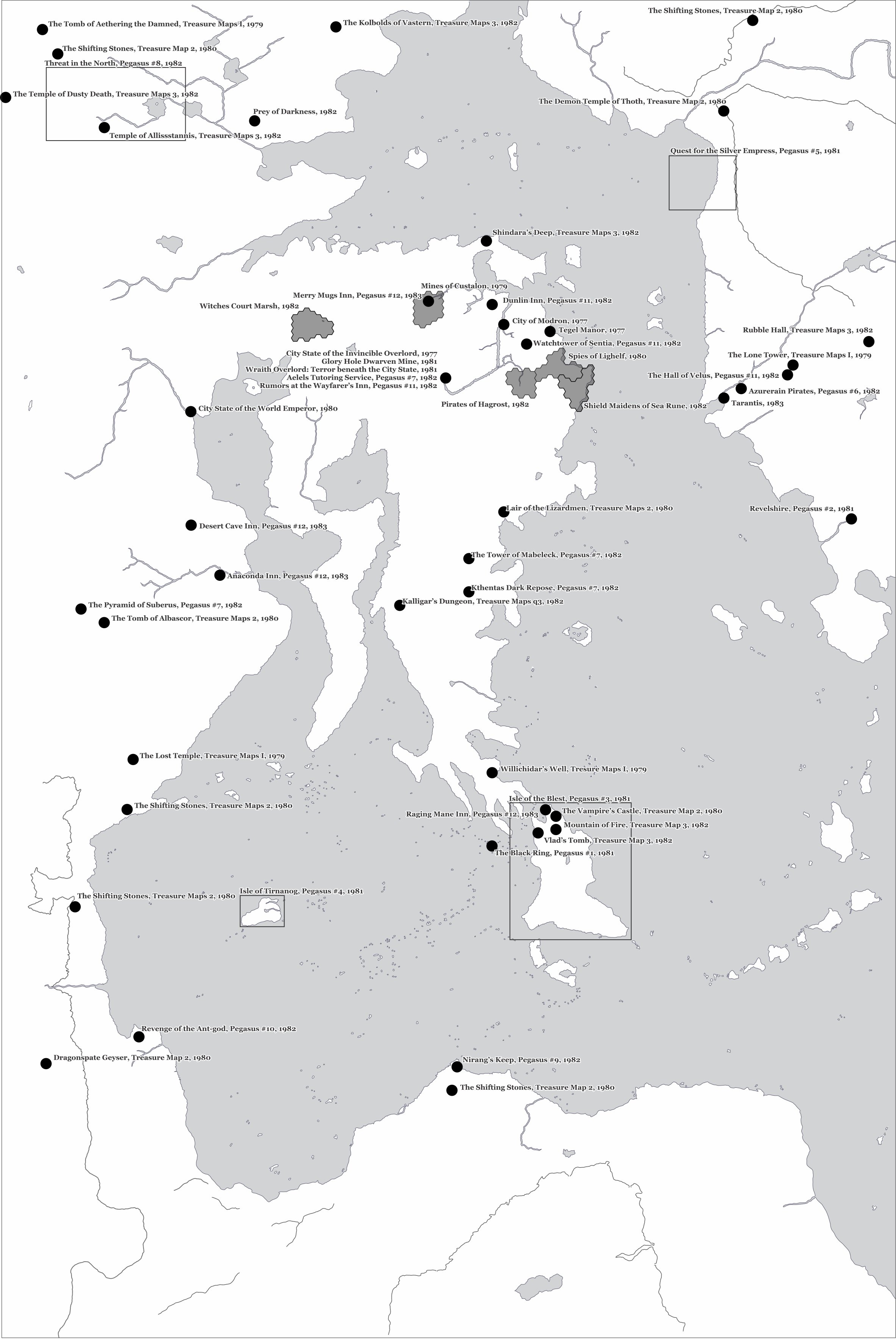Part II
After the end of the last post, the world of magic is dominated by clerics, religion, and divine magic. With the exception of the Elves and their allied culture where a tradition of arcane wizardry was developed along divine magic.
As world rediscovered bronze and later iron technology. Arcane magic remained in the background. Cultures and religion proved to be a barrier but not an impenetrable wall. Independent discoveries and trade with the elves slowly spread arcane knowledge, spells, and rituals. Like in Earth's history the endless summer of small regional cultures doing their own things was to be shattered by the rise of the empires.
The Rise of the Viridians
Despite being divinely constructed and guarded by the Great Dragons, the entrance to Abyss that chromatic crystals guarded was a location in the world that could discovered and explored. Chance and circumstance combined with evil intent to allow a powerful wizard to steal one of the chromatic crystals, the Ebon Flame. The story of that wizard and the war against him is epic but is a tale for another time.
The theft of the crystal left a gap within the ward. and a thousand years later, the weakest of demons the Green Lords or the Viridians found the gap and they were just weak enough that they could use it to escape. Once free they sailed away and founded an empire. Soon other races including the Elves came into conflict with the Viridians and war broke out.
For magic, the Viridians had the first major independent tradition of arcane magic outside of Wizardry. Demons had no access to the divine as they considered themselves enemies of creation. So they developed arcane rituals into a high art including the development of the powerful 7th to 9th level rituals.
The Rise and Fall of Empires
The Viridians did little to endear themselves to humans and the other races. They believe themselves to be lords of creations and sought to enslave whole cultures at every opportunity. But their numbers dwindled and like neighboring cultures their realms experienced a rise, a fall, a dark age, and rebirth. In both the Majestic Wilderlands and the Majestic Fantasy Realms there were three empires over the centuries. The downside of how the Viridians acted that for many cultures, arcane magic became associated with demons and evil. It wasn't until the rise of the next great empire that arcane magic came into it's own.
That empire was the Ghinorian Empire in the Majestic Wilderlands, and the Bright Empire in the Majestic Fantasy Realms. Both considered themselves universal empire espousing ideals to appeal to all people regardless of cultures. Both had a dominant religion that preached these ideals as divinely ordained and both were highly successful in spreading to all corners of the main continent.
Like most religions in other cultures, the empire had a tradition of Arcanists subordinated to the church. One specialty found among others in various orders of scholars and monks. The success of the empire meant contact with many different cultures including the Elves and their tradition of Wizardry. And the Viridians and their tainted tradition of arcane magic. This widespread contact lead to renaissance of learning and scholarship spearheaded by the church.
But as the centuries rolled on, the empire developed cracks and faltered. Both versions weakened by civil war, and both had their death blow delivered by barbarian invasions. In the chaotic centuries after the fall, the church shattered and it adherent left to fend on their own. The old arcanist used their knowledge of elven wizardry, the rituals of over a dozen cultures, and Viridian own tradition scrubbed of any demonic taint to create a new form of arcane magic, the Magic User. Freed by the demand and constraints of religion the early magic-users were able to prefect the new way of casting spells and teach it to others.
Like a wizard a magic user performed mediations to memorize a spell form that could be filled with energy and released as spell. But instead of internalizing the forms, they made a crucial innovation of the spell book. The use of the spell book allowed many more forms to kept in a magic user's mind compared to a wizard. In addition it only took a short amount of time to rememorize new forms. Although the number and powers of the memorized forms depended on the skill of the magic orders.
The Magical Orders.
 |
| Art by Richard Luschek |
The centuries after the empire's fall saw the rise of various magic orders. The Order of Thoth arose from some of the early magic-users banding together for protection. The Order of Sarrath was an alternative tradition of ritual casters that became an important part of the Ochre Empire one of the largest successor realms to emerge from the collapse of the Bright Empire. The various viking cultures developed an order of ritual casters using runes. Alongside these new order Wizards from the elves and their allies and Viridian artificers who used the old form of ritual magic to create magic items.
All of the orders are still finding their way. The present day of my campaigns in both the Majestic Wilderlands and the Majestic Fantasy Realms is set during the time where these orders are coming into their own. The turmoil's of their early history is past and each have established a place in their respective cultures.
The wider world is also coming into its own as the various realms have move past the dark age after the fall of the empire. Commerce and finance has step alongside land as a source of wealth and power. And nobody know what the next few centuries will bring either for the realms or magic.
The Mechanics
Magic Users
The same as any classic edition. Additionally magic users can cast 10 minute rituals from their spellbooks. The maximum level they can cast as a ritual is equal to 1/2 of the high spell level they can cast (rounded down). If a magic-user can cast 4th level spells they can also cast 2nd level spells as ritual. In this area magic-users regressed compared to the older ritual caster due to the focusing on memorizing spells.
Order of Thoth
The same as magic users above. In addition they learn the Shield of Magic which confers 20% magic resistance per level until it maxes out at 100% at 5th level when they become a master in the order. I recommend limiting this to non-damaging spells that require a save like charm person. Not to spells like fireball or stinking cloud that create something else that does the damage. The Shield of Magic was developed to protect mages from being controlled as a slave by another mage.
Order of Sarrath
This is a order of the ritual only spell casters known as Theurgists. As an official arm of an empire dedicated to worship of the dragon god of war and order (think lawful evil) these spellcasters learn to cast joint rituals. They can combine their caster levels for an increased spells effect. For example 5 5th level Theurgists can cast a 25D fireball.
Rob's Note: I have to admit, I thought this would work out better than it did. At the time I thought there were a fair amount of spells in the classic editions like fireball where they were more effective when cast by higher level magic users. This turned out the exception not the rule for the classic editions.
But would out work out fine if 5e is being used. In 5e most spells are more potent when cast through a higher level spell slot.
Runecasters
This is another order of ritual only spell casters originated among the dwarves and human viking cultures who used runes. Instead of scrolls runecaster can scribe runes that function the same. Used the spell is cast and the rune disappears. The difference is that runes are more compact so Runecaster can make runewands or runestaffs with many runes on them. And they are more lasting than paper being carving into a durable material like wood or stone. Runes for a spell take up around three inches of length for a staff or wand. A three inch by three inch square on a flat surface.
Charms
Charms are like scrolls except they remain after being used. They cost double (money and time) what a scroll costs and half to recharge (money and time). They also can be activated by non-spellcasters as one-use magic item. For runecasters they are an advanced form of runes.
Wrapping it up.
My hope with this short series of essays on magic and society provide some useful insight and inspirations for your own campaign. The history of magic I outlined is not the only way it could have played out. With different premises and history turning in a different all kinds of interesting possibilities emerge.
One thing to keep in mind if you believe that a magic utopia is inevitable. Once way to sidestep that issue to set the campaign prior to the time in which the utopia will happen. Everything has a beginning and Rome wasn't build in a day.
Finally this material is also preview of the upcoming Lost Grimoire of Magic. The next book in my Majestic Fantasy RPG series with will debut late this summer after the Wild North is released.
















































